Company and Commercial Law: Case Study on Brian and Clara's Dispute
VerifiedAdded on 2023/02/01
|9
|1465
|62
Case Study
AI Summary
This case study examines the legal dispute between Brian and Clara, focusing on company and commercial law principles. Part A analyzes the issue of misrepresentation, where Brian falsely represented the condition of a laptop to Clara, leading her to purchase it. The analysis covers the rules of contract formation, including the requirement of free consent and the elements of misrepresentation. Part B delves into the Australian Consumer Law (ACL), specifically the consumer guarantees related to acceptable quality and fitness for purpose. The case assesses Brian's liability under sections 54 and 55 of the ACL, highlighting the major failures of the laptop. Part C explores potential liability under common law, specifically the tort of negligence, considering Brian's duty of care and potential product liability. The conclusion summarizes Brian's legal obligations, including returning the purchase price and potentially paying damages, as well as the importance of providing accurate product information to avoid future claims. The case study references relevant legal precedents such as Horsfall v Thomas and Donoghue v Stevenson to support the analysis.
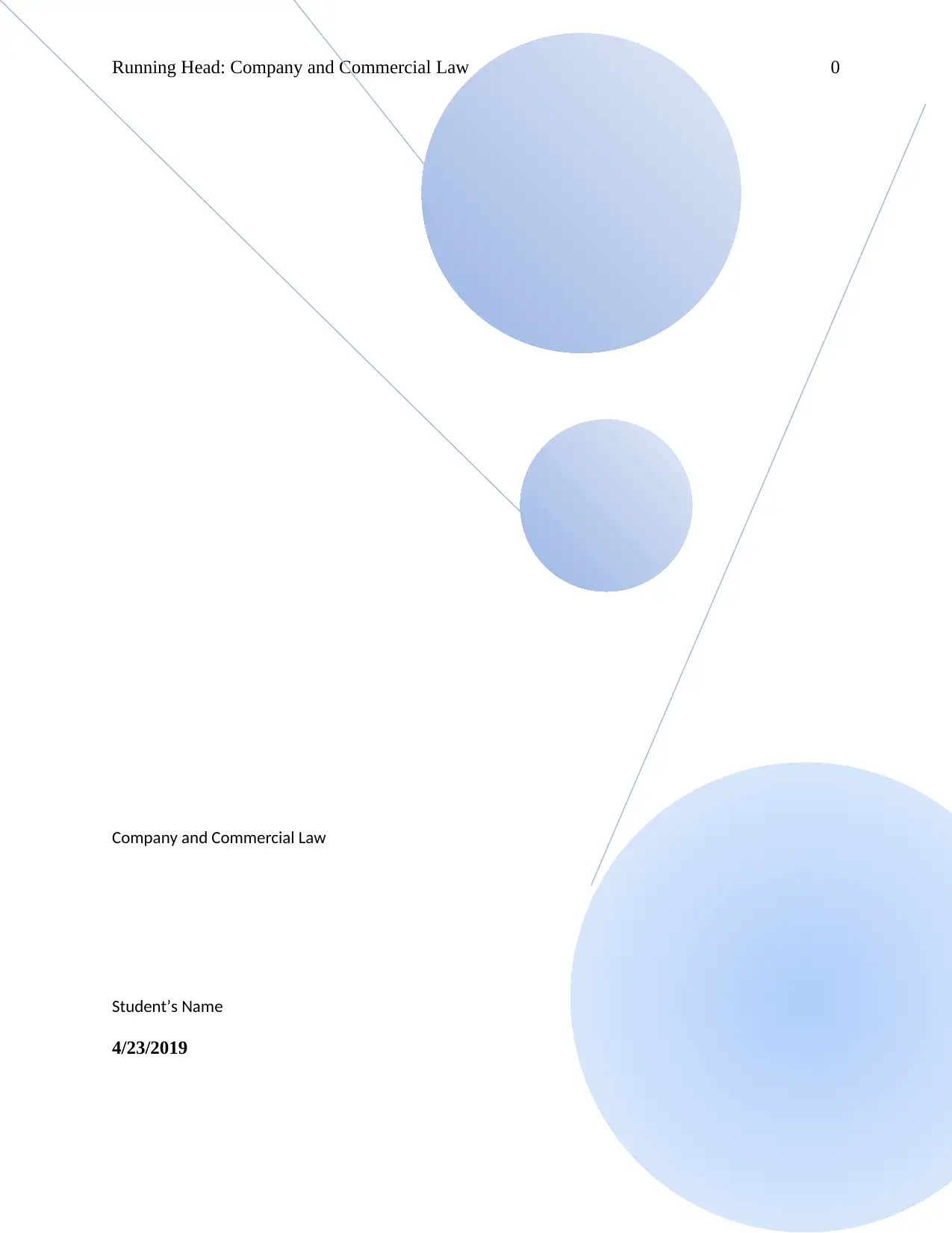
Running Head: Company and Commercial Law 0
Company and Commercial Law
Student’s Name
4/23/2019
Company and Commercial Law
Student’s Name
4/23/2019
Paraphrase This Document
Need a fresh take? Get an instant paraphrase of this document with our AI Paraphraser
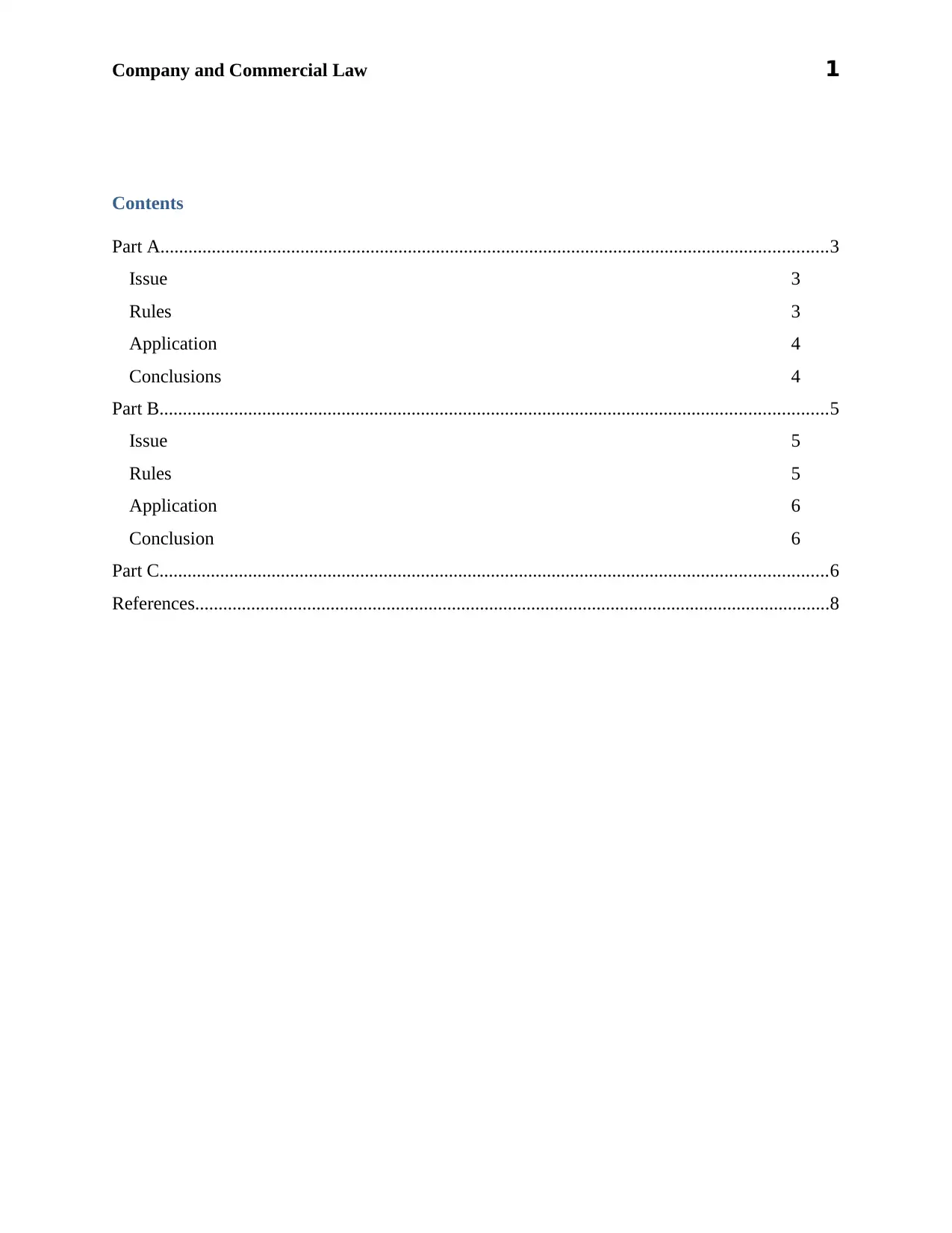
Company and Commercial Law 1
Contents
Part A...............................................................................................................................................3
Issue 3
Rules 3
Application 4
Conclusions 4
Part B...............................................................................................................................................5
Issue 5
Rules 5
Application 6
Conclusion 6
Part C...............................................................................................................................................6
References........................................................................................................................................8
Contents
Part A...............................................................................................................................................3
Issue 3
Rules 3
Application 4
Conclusions 4
Part B...............................................................................................................................................5
Issue 5
Rules 5
Application 6
Conclusion 6
Part C...............................................................................................................................................6
References........................................................................................................................................8
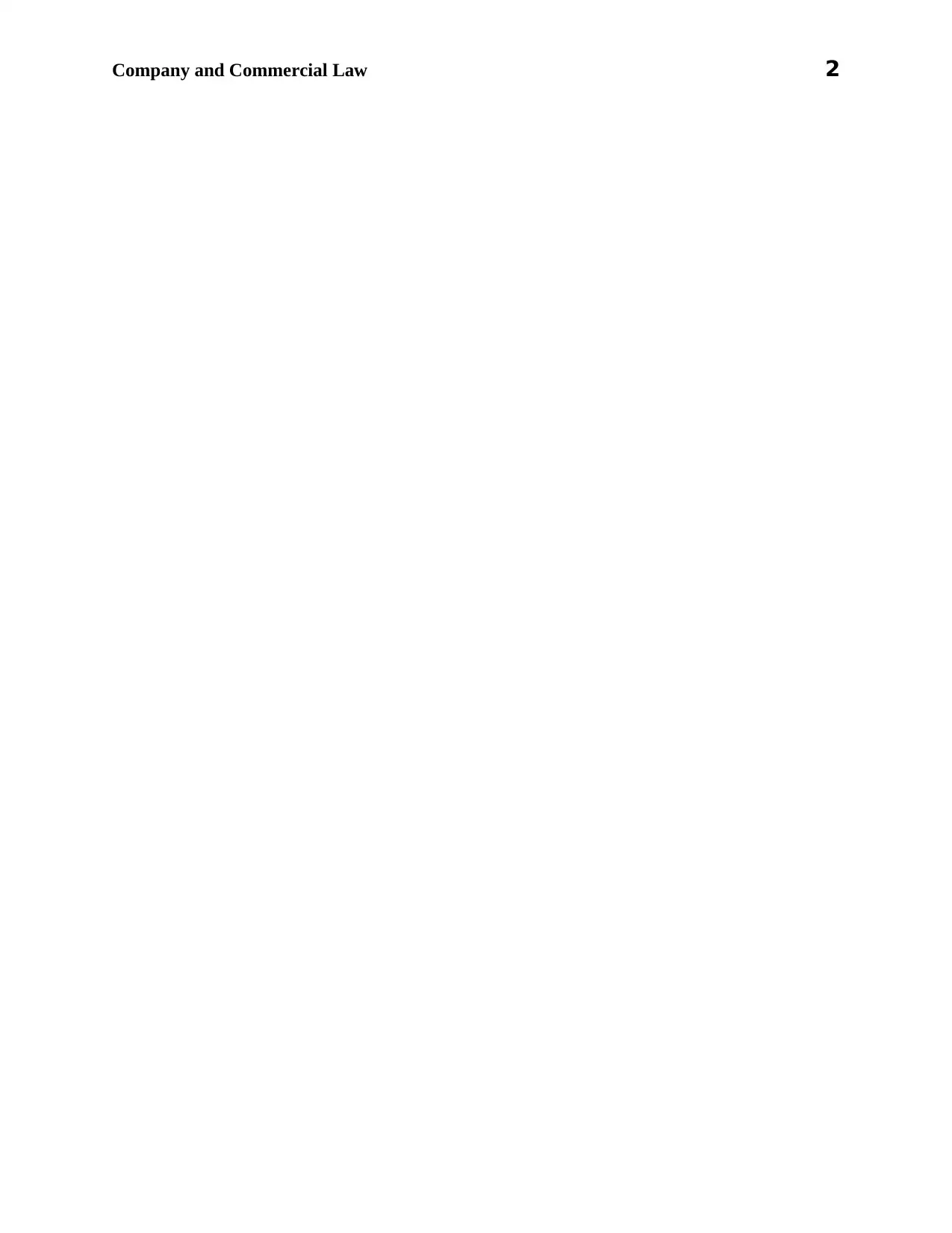
Company and Commercial Law 2
⊘ This is a preview!⊘
Do you want full access?
Subscribe today to unlock all pages.

Trusted by 1+ million students worldwide
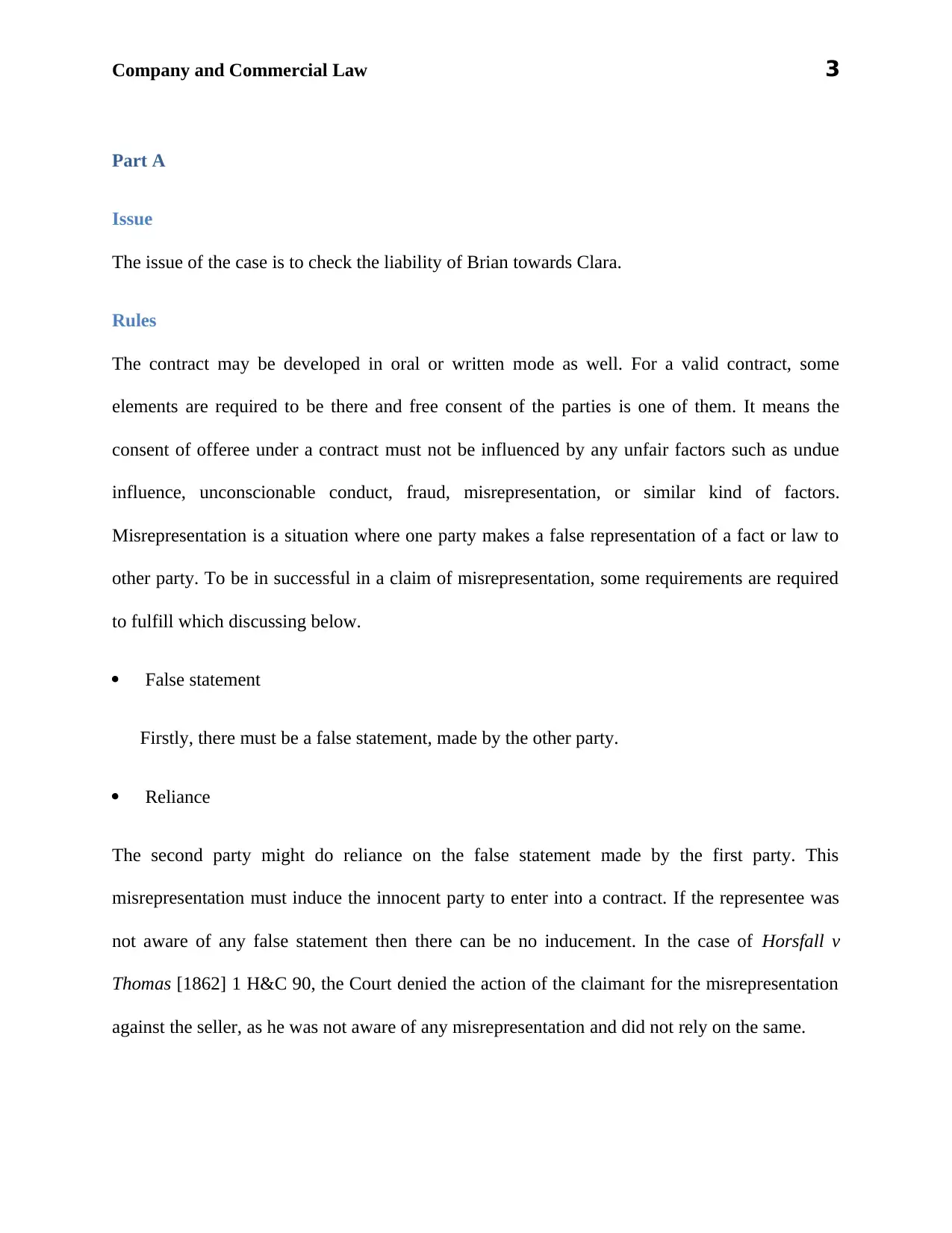
Company and Commercial Law 3
Part A
Issue
The issue of the case is to check the liability of Brian towards Clara.
Rules
The contract may be developed in oral or written mode as well. For a valid contract, some
elements are required to be there and free consent of the parties is one of them. It means the
consent of offeree under a contract must not be influenced by any unfair factors such as undue
influence, unconscionable conduct, fraud, misrepresentation, or similar kind of factors.
Misrepresentation is a situation where one party makes a false representation of a fact or law to
other party. To be in successful in a claim of misrepresentation, some requirements are required
to fulfill which discussing below.
False statement
Firstly, there must be a false statement, made by the other party.
Reliance
The second party might do reliance on the false statement made by the first party. This
misrepresentation must induce the innocent party to enter into a contract. If the representee was
not aware of any false statement then there can be no inducement. In the case of Horsfall v
Thomas [1862] 1 H&C 90, the Court denied the action of the claimant for the misrepresentation
against the seller, as he was not aware of any misrepresentation and did not rely on the same.
Part A
Issue
The issue of the case is to check the liability of Brian towards Clara.
Rules
The contract may be developed in oral or written mode as well. For a valid contract, some
elements are required to be there and free consent of the parties is one of them. It means the
consent of offeree under a contract must not be influenced by any unfair factors such as undue
influence, unconscionable conduct, fraud, misrepresentation, or similar kind of factors.
Misrepresentation is a situation where one party makes a false representation of a fact or law to
other party. To be in successful in a claim of misrepresentation, some requirements are required
to fulfill which discussing below.
False statement
Firstly, there must be a false statement, made by the other party.
Reliance
The second party might do reliance on the false statement made by the first party. This
misrepresentation must induce the innocent party to enter into a contract. If the representee was
not aware of any false statement then there can be no inducement. In the case of Horsfall v
Thomas [1862] 1 H&C 90, the Court denied the action of the claimant for the misrepresentation
against the seller, as he was not aware of any misrepresentation and did not rely on the same.
Paraphrase This Document
Need a fresh take? Get an instant paraphrase of this document with our AI Paraphraser
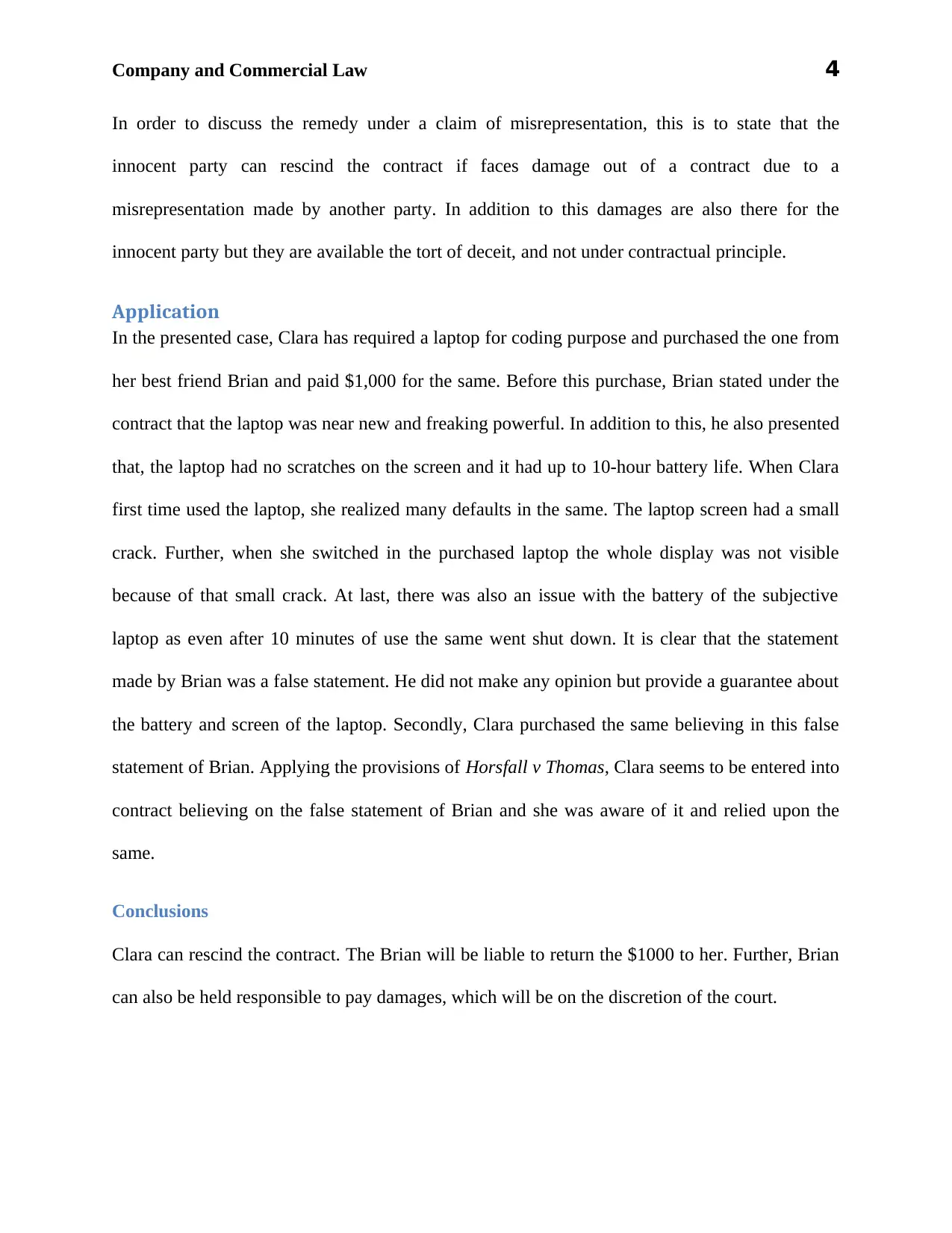
Company and Commercial Law 4
In order to discuss the remedy under a claim of misrepresentation, this is to state that the
innocent party can rescind the contract if faces damage out of a contract due to a
misrepresentation made by another party. In addition to this damages are also there for the
innocent party but they are available the tort of deceit, and not under contractual principle.
Application
In the presented case, Clara has required a laptop for coding purpose and purchased the one from
her best friend Brian and paid $1,000 for the same. Before this purchase, Brian stated under the
contract that the laptop was near new and freaking powerful. In addition to this, he also presented
that, the laptop had no scratches on the screen and it had up to 10-hour battery life. When Clara
first time used the laptop, she realized many defaults in the same. The laptop screen had a small
crack. Further, when she switched in the purchased laptop the whole display was not visible
because of that small crack. At last, there was also an issue with the battery of the subjective
laptop as even after 10 minutes of use the same went shut down. It is clear that the statement
made by Brian was a false statement. He did not make any opinion but provide a guarantee about
the battery and screen of the laptop. Secondly, Clara purchased the same believing in this false
statement of Brian. Applying the provisions of Horsfall v Thomas, Clara seems to be entered into
contract believing on the false statement of Brian and she was aware of it and relied upon the
same.
Conclusions
Clara can rescind the contract. The Brian will be liable to return the $1000 to her. Further, Brian
can also be held responsible to pay damages, which will be on the discretion of the court.
In order to discuss the remedy under a claim of misrepresentation, this is to state that the
innocent party can rescind the contract if faces damage out of a contract due to a
misrepresentation made by another party. In addition to this damages are also there for the
innocent party but they are available the tort of deceit, and not under contractual principle.
Application
In the presented case, Clara has required a laptop for coding purpose and purchased the one from
her best friend Brian and paid $1,000 for the same. Before this purchase, Brian stated under the
contract that the laptop was near new and freaking powerful. In addition to this, he also presented
that, the laptop had no scratches on the screen and it had up to 10-hour battery life. When Clara
first time used the laptop, she realized many defaults in the same. The laptop screen had a small
crack. Further, when she switched in the purchased laptop the whole display was not visible
because of that small crack. At last, there was also an issue with the battery of the subjective
laptop as even after 10 minutes of use the same went shut down. It is clear that the statement
made by Brian was a false statement. He did not make any opinion but provide a guarantee about
the battery and screen of the laptop. Secondly, Clara purchased the same believing in this false
statement of Brian. Applying the provisions of Horsfall v Thomas, Clara seems to be entered into
contract believing on the false statement of Brian and she was aware of it and relied upon the
same.
Conclusions
Clara can rescind the contract. The Brian will be liable to return the $1000 to her. Further, Brian
can also be held responsible to pay damages, which will be on the discretion of the court.

Company and Commercial Law 5
Part B
Issue
To check the liability of Brian under the provisions related to consumer guarantee mentioned in
Australian Consumer Law and to check out the remedies that Brian will be liable to offer to
Clara.
Rules
Part 3-2 of Australian Consumer Law (ACL) prescribes some of the guarantees that the seller of
goods is required to provide to his/her consumers. Section 54 of the act is a significant section
that states the Guarantee as to acceptable quality. As per this section, goods seem to be of
acceptable quality if the same are durable, safe, free from defects, and fit for the general purpose.
It becomes the responsibility of every seller/trader to provide those goods only which are of
acceptable quality. Sometimes, a consumer purchases some goods for a special purpose and
discloses the same to the seller. In such a situation it becomes the responsibility of the seller to
provide the goods, which are fit for that, disclosed the purpose and under section 55 of the act,
the consumer gets a guarantee that the seller will provide the goods which are fit for that specific
purpose only. As per section 260 of the act, a failure will be considered as a major failure if the
goods are not of acceptable quality and the same are not fit for a disclosed purpose. Further
section 259 (3) of the act says that in case of major failures, the consumer has the right to reject
the goods by informing the same to the supplier. In addition to this, the consumer may recover
compensation for the value reduction of goods. Here this is necessary to state that a consumer is
only eligible for the consumer guarantees where the amount of goods is less than $40000 and the
goods must be acquired for personal use.
Part B
Issue
To check the liability of Brian under the provisions related to consumer guarantee mentioned in
Australian Consumer Law and to check out the remedies that Brian will be liable to offer to
Clara.
Rules
Part 3-2 of Australian Consumer Law (ACL) prescribes some of the guarantees that the seller of
goods is required to provide to his/her consumers. Section 54 of the act is a significant section
that states the Guarantee as to acceptable quality. As per this section, goods seem to be of
acceptable quality if the same are durable, safe, free from defects, and fit for the general purpose.
It becomes the responsibility of every seller/trader to provide those goods only which are of
acceptable quality. Sometimes, a consumer purchases some goods for a special purpose and
discloses the same to the seller. In such a situation it becomes the responsibility of the seller to
provide the goods, which are fit for that, disclosed the purpose and under section 55 of the act,
the consumer gets a guarantee that the seller will provide the goods which are fit for that specific
purpose only. As per section 260 of the act, a failure will be considered as a major failure if the
goods are not of acceptable quality and the same are not fit for a disclosed purpose. Further
section 259 (3) of the act says that in case of major failures, the consumer has the right to reject
the goods by informing the same to the supplier. In addition to this, the consumer may recover
compensation for the value reduction of goods. Here this is necessary to state that a consumer is
only eligible for the consumer guarantees where the amount of goods is less than $40000 and the
goods must be acquired for personal use.
⊘ This is a preview!⊘
Do you want full access?
Subscribe today to unlock all pages.

Trusted by 1+ million students worldwide

Company and Commercial Law 6
Application
In the given case, Clara purchased the laptop as recommended by Brain and paid an additional
$1500. When she returned to the home, she decided to enroll herself for the online coding
course. Later on, her laptop was crashed, as the same was not supportive of the coding program.
Applying the provisions of the ACL, this is to state that Clara had consumer guaranteed under
section 54 where Brian was required to provide laptop of acceptable quality. Further, she
informed her intention to Brian and he was aware of the fact that Clara especially wanted the
laptop for coding purpose. In a manner, the guarantee mentioned under section 55 of the
subjective act was also applicable to the case. Brian failed to fulfill both of these guarantees. The
laptop was not of acceptable quality and the same was also not fit for the disclosed purpose.
These were the major failures as per the provisions of section 260 of the act.
Conclusion
Brian has to offer compensation for the reduced value of laptop or he has to offer the refund of
the whole amount of laptop i.e. $2500 to Clara, if she wants so as a remedy.
Part C
Apart from the contractual breach risk and risk under ACL, one of the other risks is also there
that Brian can have under common law. The area is related to tort. It is known to everyone that a
tort is a civil wrong and negligence is one of the most common types of tort. Negligence is a
situation where a person fails to take proper care as a reasonable person and breach the duty of
care. In cases of the sell of a product, product liability and negligence becomes an important
area. To be successful in a claim of product negligence, the followings conditions are required to
be fulfilled:-
Application
In the given case, Clara purchased the laptop as recommended by Brain and paid an additional
$1500. When she returned to the home, she decided to enroll herself for the online coding
course. Later on, her laptop was crashed, as the same was not supportive of the coding program.
Applying the provisions of the ACL, this is to state that Clara had consumer guaranteed under
section 54 where Brian was required to provide laptop of acceptable quality. Further, she
informed her intention to Brian and he was aware of the fact that Clara especially wanted the
laptop for coding purpose. In a manner, the guarantee mentioned under section 55 of the
subjective act was also applicable to the case. Brian failed to fulfill both of these guarantees. The
laptop was not of acceptable quality and the same was also not fit for the disclosed purpose.
These were the major failures as per the provisions of section 260 of the act.
Conclusion
Brian has to offer compensation for the reduced value of laptop or he has to offer the refund of
the whole amount of laptop i.e. $2500 to Clara, if she wants so as a remedy.
Part C
Apart from the contractual breach risk and risk under ACL, one of the other risks is also there
that Brian can have under common law. The area is related to tort. It is known to everyone that a
tort is a civil wrong and negligence is one of the most common types of tort. Negligence is a
situation where a person fails to take proper care as a reasonable person and breach the duty of
care. In cases of the sell of a product, product liability and negligence becomes an important
area. To be successful in a claim of product negligence, the followings conditions are required to
be fulfilled:-
Paraphrase This Document
Need a fresh take? Get an instant paraphrase of this document with our AI Paraphraser

Company and Commercial Law 7
Vendor/manufacturer must owe a duty of care as established under the case of Donoghue
v Stevenson [1932] AC 562
Such duty must have been breached
There must be a loss to the plaintiff
The lead reason for such loss must be the negligence of the manufacturer/vendor.
All the above conditions seem to be satisfied in the case of Clara and Brian and therefore Brian
can be held liable for product negligence. This risk can be managed by informing the true
situation of products to the consumer in the future so they can make the claim for negligence.
Vendor/manufacturer must owe a duty of care as established under the case of Donoghue
v Stevenson [1932] AC 562
Such duty must have been breached
There must be a loss to the plaintiff
The lead reason for such loss must be the negligence of the manufacturer/vendor.
All the above conditions seem to be satisfied in the case of Clara and Brian and therefore Brian
can be held liable for product negligence. This risk can be managed by informing the true
situation of products to the consumer in the future so they can make the claim for negligence.

Company and Commercial Law 8
References
Donoghue v Stevenson [1932] AC 562
Horsfall v Thomas [1862] 1 H&C 90
References
Donoghue v Stevenson [1932] AC 562
Horsfall v Thomas [1862] 1 H&C 90
⊘ This is a preview!⊘
Do you want full access?
Subscribe today to unlock all pages.

Trusted by 1+ million students worldwide
1 out of 9
Related Documents
Your All-in-One AI-Powered Toolkit for Academic Success.
+13062052269
info@desklib.com
Available 24*7 on WhatsApp / Email
![[object Object]](/_next/static/media/star-bottom.7253800d.svg)
Unlock your academic potential
Copyright © 2020–2025 A2Z Services. All Rights Reserved. Developed and managed by ZUCOL.





